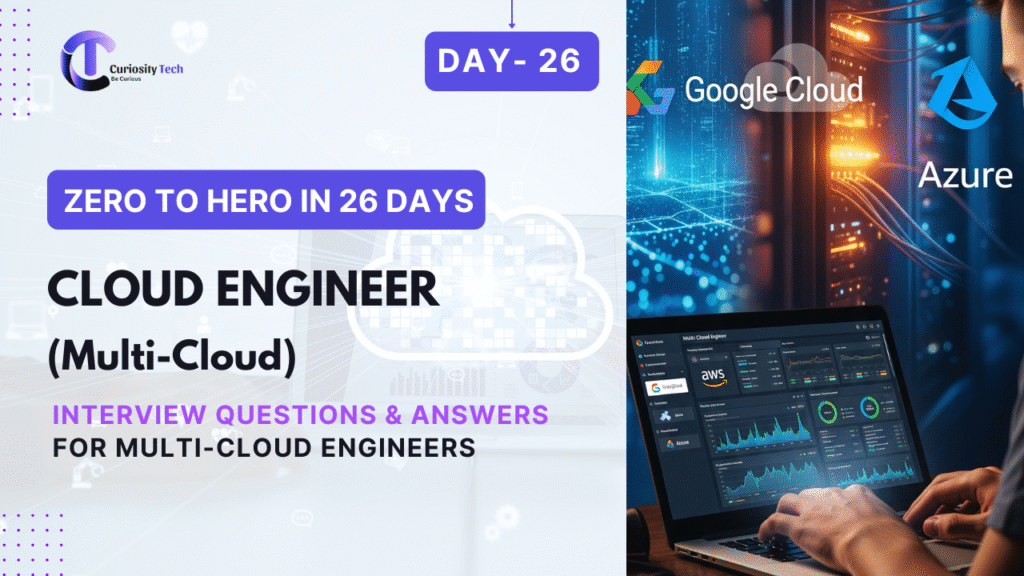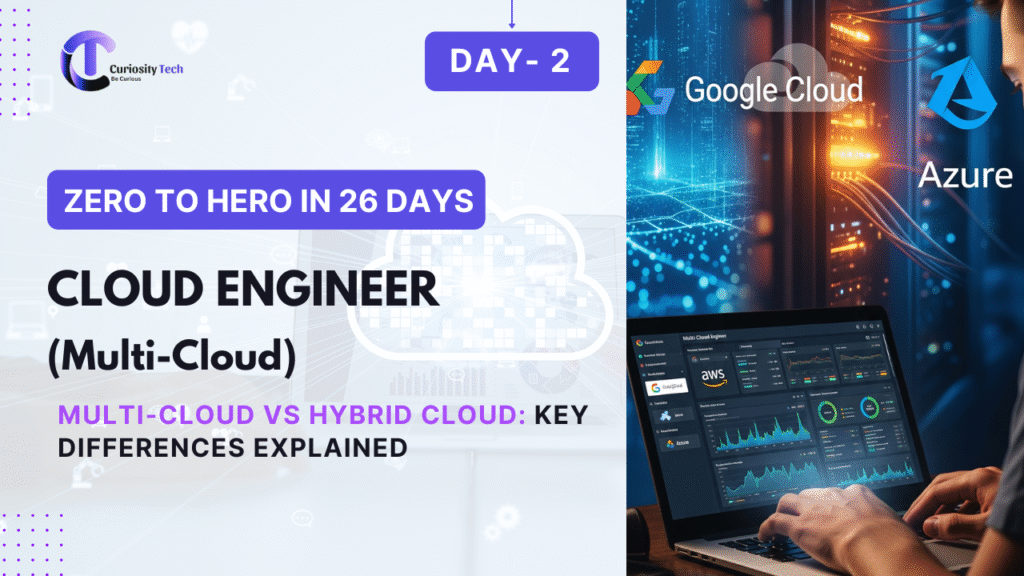Introduction
Multi-cloud engineers are among the most in-demand professionals in 2025. Enterprises expect candidates to demonstrate:
- Deep understanding of AWS, Azure, and GCP services
- Skills in architecture, automation, security, governance, and cost optimization
- Practical experience from hands-on labs and real-world deployments
At CuriosityTech.in, we prepare engineers with simulated multi-cloud interviews, lab scenarios, and real-world problem-solving exercises to ensure they are confident, knowledgeable, and job-ready.
This blog provides 50 interview questions with detailed answers, covering foundational to advanced topics.
Section 1 – General Multi-Cloud Concepts
Q1. What is multi-cloud and why do enterprises adopt it?
Multi-cloud refers to using two or more cloud providers to deploy workloads. Enterprises adopt it for:
- Avoiding vendor lock-in
- Resilience & high availability
- Optimized pricing & regional compliance
- Leveraging best-of-breed services from each provider
Q2. Explain the shared responsibility model.
Each cloud provider is responsible for security of the cloud (hardware, infrastructure, global network), while the customer is responsible for security in the cloud (data, applications, IAM, configurations).
Q3. Name differences in IAM across AWS, Azure, and GCP.
- AWS: IAM Users, Roles, Policies, Groups
- Azure: Azure Active Directory, RBAC roles, Conditional Access
- GCP: IAM Roles, Service Accounts, Permissions
Q4. How do you ensure governance in a multi-cloud environment?
Implement policy-as-code, centralized logging, compliance checks, automated audits, and unified governance dashboards.
Q5. What are common challenges in multi-cloud deployments?
Complexity in networking, inconsistent security, cost overruns, monitoring blind spots, compliance challenges.
Section 2 – AWS-Specific Questions
Q6. Explain VPC and its components.
A VPC (Virtual Private Cloud) is a logical network in AWS. Components include Subnets, Route Tables, Internet Gateway, NAT Gateway, Security Groups, and Network ACLs.
Q7. Difference between Security Group and NACL?
- Security Group: Stateful firewall at instance level
- NACL: Stateless network firewall at subnet level
Q8. How do you implement cross-region disaster recovery in AWS?
Use multi-region replication, snapshots, Route 53 DNS failover, and S3 Cross-Region Replication.
Q9. What is AWS Organizations?
AWS Organizations helps manage multiple accounts centrally, enforce policies, and consolidate billing.
Q10. Explain AWS Lambda use cases in multi-cloud.
Serverless compute for event-driven tasks:
- Auto-processing data from S3
- Triggering functions across cloud services
- Integrating with API Gateway for microservices
Section 3 – Azure-Specific Questions
Q11. What is Azure Resource Manager (ARM)?
ARM enables declarative deployment and management of Azure resources using templates.
Q12. Explain Azure Availability Zones.
Physically separate data centers within a region to ensure high availability and fault tolerance.
Q13. How do you manage identities in Azure?
Azure Active Directory (AAD) manages users, groups, and roles with RBAC and Conditional Access policies.
Q14. What is Azure Policy and why is it important?
Azure Policy enforces compliance rules and governance across subscriptions, ensuring resources meet organizational standards.
Q15. How do you monitor multi-cloud resources using Azure?
Use Azure Monitor, Log Analytics, and integrate with Datadog or Grafana for centralized observability.
Section 4 – GCP-Specific Questions
Q16. What is Google Cloud IAM?
IAM defines who (identity) has what access (roles) to which resources. Supports primitive, predefined, and custom roles.
Q17. Explain GCP VPC and its global nature.
GCP VPC is global, spanning regions. Subnets are regional. Connectivity uses private IP ranges and optional Cloud VPN/Interconnect.
Q18. How do you implement multi-cloud disaster recovery with GCP?
Use cross-cloud replication, Cloud Storage Nearline/Coldline, multi-region databases, and traffic management with DNS.
Q19. What is Google Cloud Functions?
Serverless execution environment for event-driven workloads similar to AWS Lambda or Azure Functions.
Q20. Explain Cloud Audit Logs.
Provides immutable, detailed logs for access, admin activity, and data events — critical for compliance and incident investigation.
Section 5 – Networking Questions
Q21. How do you connect AWS, Azure, and GCP securely?
Use VPN tunnels, private interconnects, or SD-WAN solutions. Ensure encryption in transit, firewalls, and proper routing policies.
Q22. Explain VPC peering vs VPN in multi-cloud.
- VPC Peering: Private communication within the same cloud or region
- VPN: Encrypted tunnel over public networks between clouds
Q23. What is latency optimization in multi-cloud networks?
Use edge locations, CDNs, geo-routing, and traffic shaping to reduce cross-cloud latency.
Q24. How do you implement load balancing across multiple clouds?
Use DNS-based global load balancers like AWS Route 53, GCP Cloud DNS, or third-party solutions like F5, NS1.
Q25. Explain security best practices for cross-cloud networking.
Segmentation, encryption, least-privilege access, firewall rules, intrusion detection, and continuous monitoring.
Section 6 – Security & IAM Questions
Q26. Explain Zero Trust in multi-cloud.
Never trust default network access; always authenticate and authorize every request across clouds.
Q27. How do you manage secrets across multi-cloud?
Centralized secrets management: HashiCorp Vault, Azure Key Vault, GCP Secret Manager.
Q28. What is multi-cloud compliance strategy?
Standardize policies, enforce via code, monitor continuously, and audit across all cloud providers.
Q29. How do you implement least privilege access?
Assign minimal roles required per user/service and regularly review permissions.
Q30. How do you handle multi-cloud encryption key management?
Use Customer-Managed Encryption Keys (CMEK) across providers, rotate keys periodically, and enforce access policies.
Section 7 – DevOps & Automation Questions
Q31. What is Infrastructure as Code (IaC)?
Declarative or programmatic definition of infrastructure. Tools: Terraform, Pulumi, ARM templates, Cloud Deployment Manager.
Q32. How do you automate multi-cloud deployments?
CI/CD pipelines integrated with IaC tools, using Jenkins, GitHub Actions, Azure DevOps.
Q33. Explain GitOps in multi-cloud.
Infrastructure is defined as code in git repos, automatically applied to multi-cloud environments.
Q34. How do you handle secrets in CI/CD pipelines?
Store encrypted secrets in Vault, Key Vault, or Secret Manager. Avoid hardcoding.
Q35. How do you implement multi-cloud blue/green deployment?
Deploy new version in parallel in a secondary cloud, test, switch DNS routing, then retire old version.
Section 8 – Monitoring & Observability Questions
Q36. How do you achieve centralized monitoring across clouds?
Use Datadog, Splunk, or Prometheus + Grafana; integrate logs, metrics, and traces from all providers.
Q37. What are common observability pitfalls?
Inconsistent logging, blind spots in cloud-native services, alert fatigue, missing trace correlation.
Q38. How do you implement SLA monitoring in multi-cloud?
Track uptime metrics, response times, and automate alerts for any provider violations.
Q39. What is synthetic monitoring?
Simulating user requests to test application performance and availability.
Q40. How do you monitor serverless functions across clouds?
Use provider-native logging (CloudWatch, Stackdriver, Azure Monitor) integrated with centralized dashboards.
Section 9 – Cost & Optimization Questions
Q41. How do you optimize multi-cloud costs?
Use cost management tools, rightsizing, auto-scaling, reserved instances, and analyze usage patterns.
Q42. What are tagging best practices?
Apply consistent tags for resources: owner, environment, project, cost center.
Q43. How do you forecast multi-cloud expenses?
Use historical usage, budgeting tools, and predictive analytics platforms.
Q44. How do you prevent unnecessary cross-cloud data transfer costs?
Optimize traffic paths, cache frequently accessed data, colocate workloads.
Q45. How do you measure ROI for multi-cloud deployments?
Compare operational efficiency, downtime reduction, scalability gains, and cost savings.
Section 10 – Scenario-Based Questions
Q46. You face high latency between AWS and GCP apps. How do you troubleshoot?
Check routing, interconnects, DNS resolution, CDN caching; perform packet tracing; optimize architecture.
Q47. Your S3 bucket is exposed publicly. How do you remediate?
Apply bucket policies, IAM roles, enable default encryption, audit access logs.
Q48. Multi-cloud serverless workflow fails intermittently. What steps do you take?
Check function logs, event triggers, cloud quotas, network configurations, retry mechanisms.
Q49. Cost spikes observed in Azure VM usage. How do you investigate?
Analyze billing reports, review auto-scaling rules, rightsizing opportunities, and orphaned resources.
Q50. You need to enforce GDPR compliance across clouds. How do you implement?
Encrypt data, implement data residency controls, access logs, automated auditing, and governance policies across all providers.
Section 11 – Interview Preparation Tips
- Practice using hands-on labs with real infrastructure.
- Mock interview sessions with peers or platforms like Pramp.
- Create personal projects showcasing multi-cloud design.
- Stay updated with AWS, Azure, and GCP blogs.
- Use cloud skill badges and certifications to validate learning.
Conclusion
Mastering multi-cloud interviews requires deep knowledge of architecture, security, cost management, automation, and real-world problem-solving. These 50 questions provide a robust foundation.
By practicing these Q&As, engaging in labs at CuriosityTech.in, and simulating production-level challenges, you’ll build the confidence and skills to succeed in modern cloud engineering roles.



